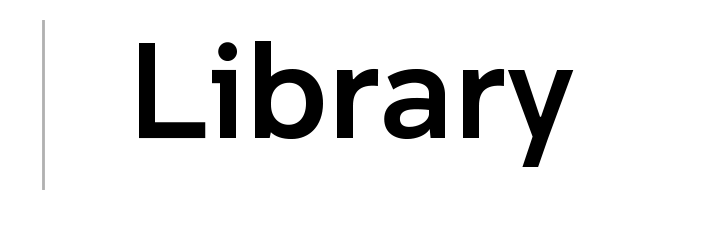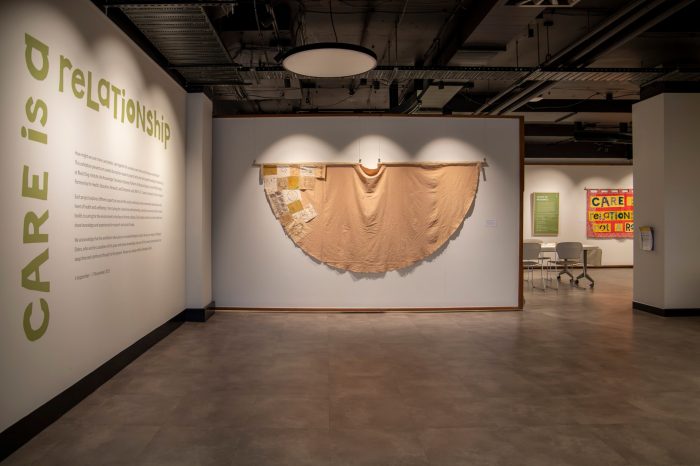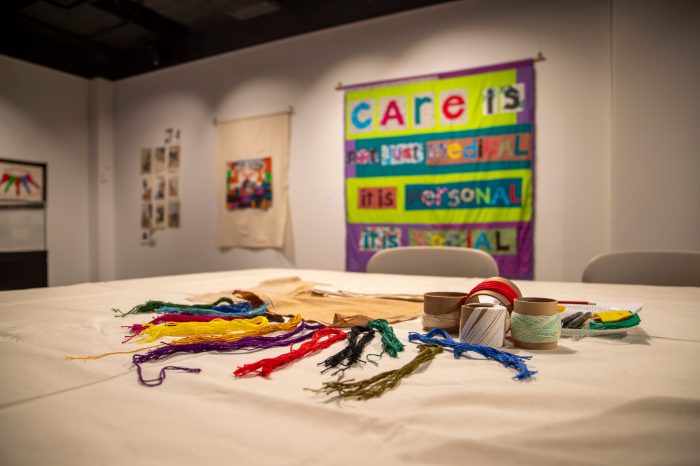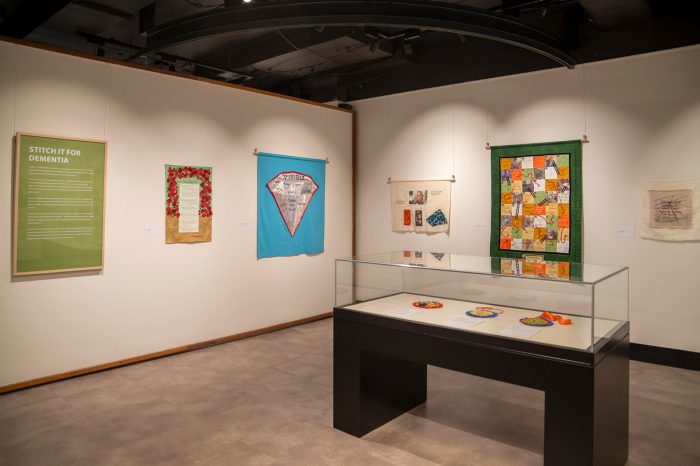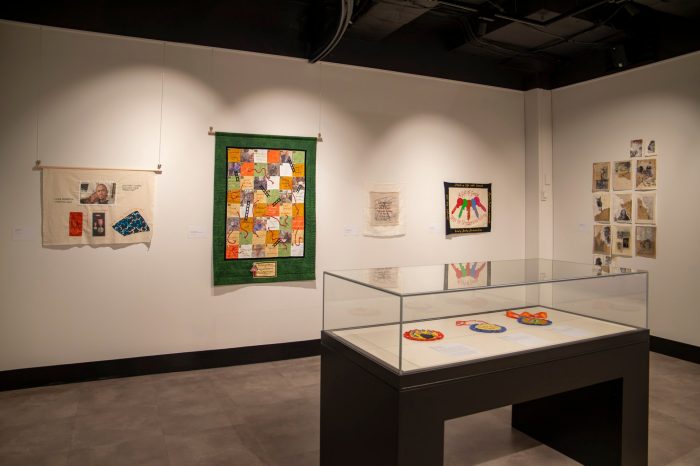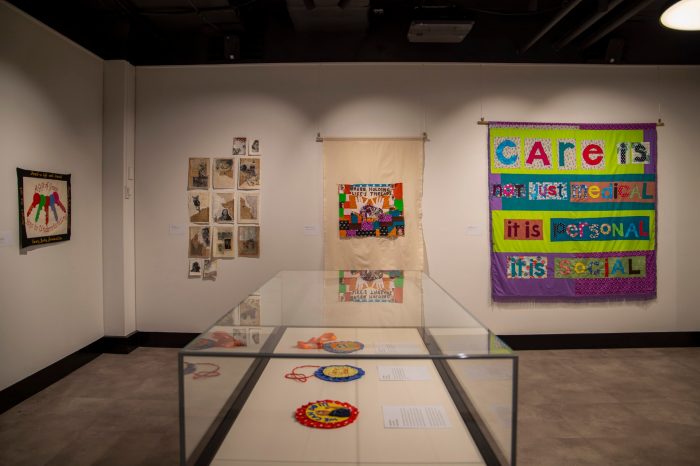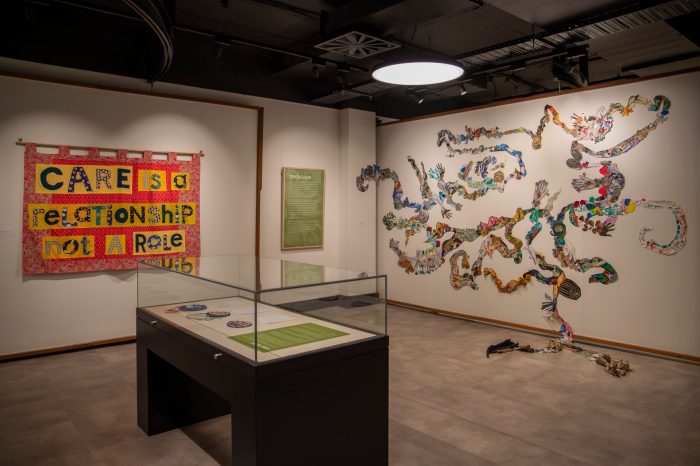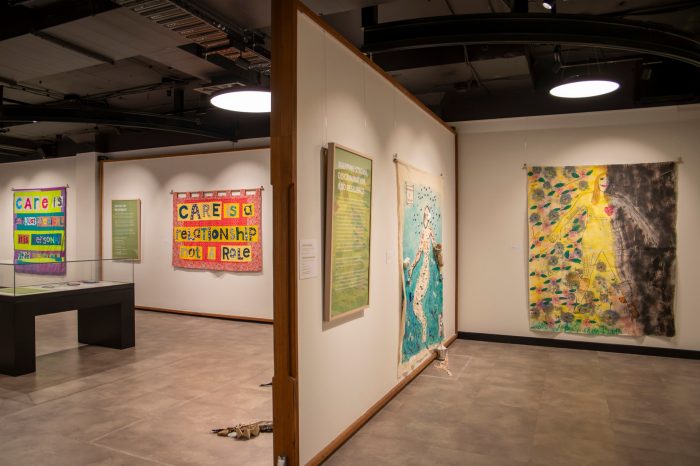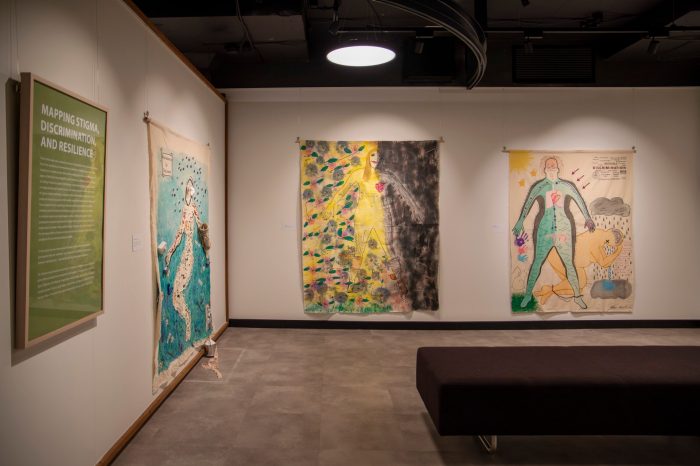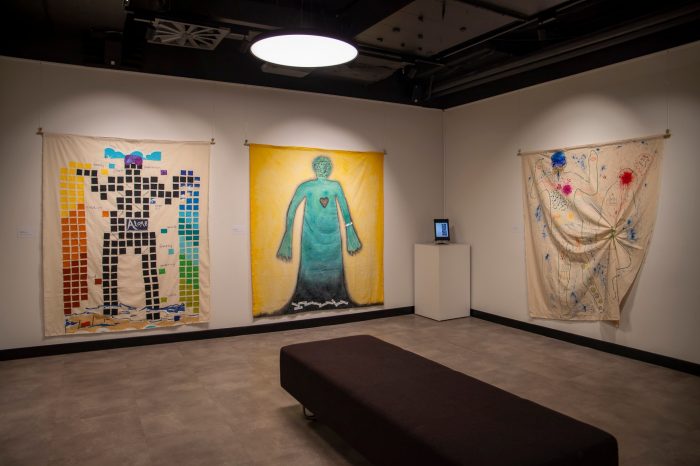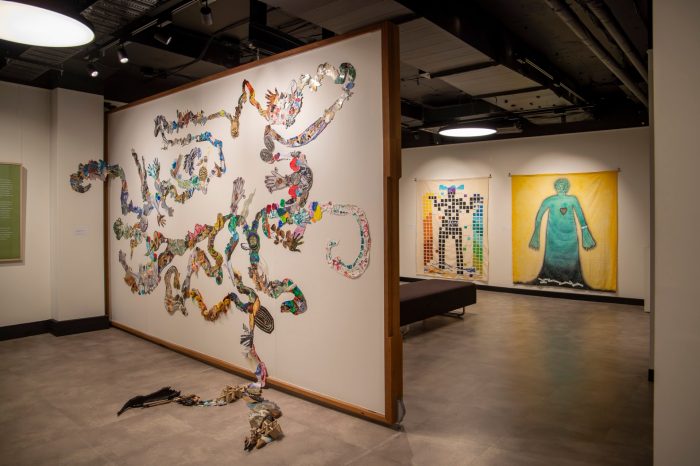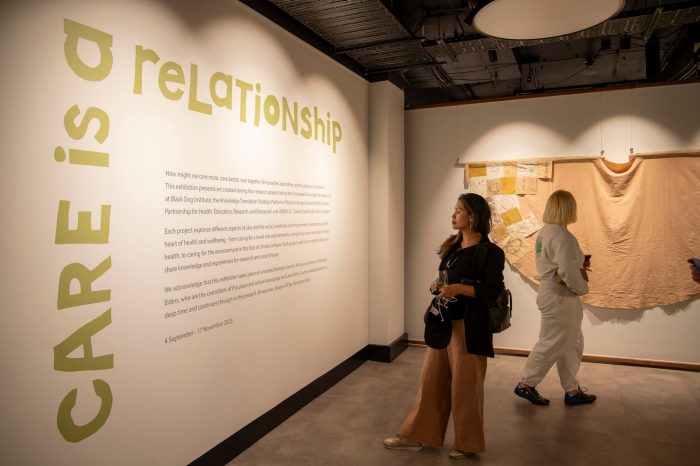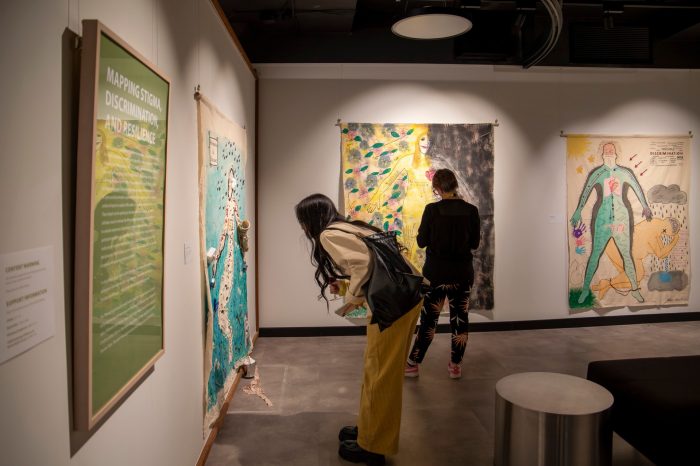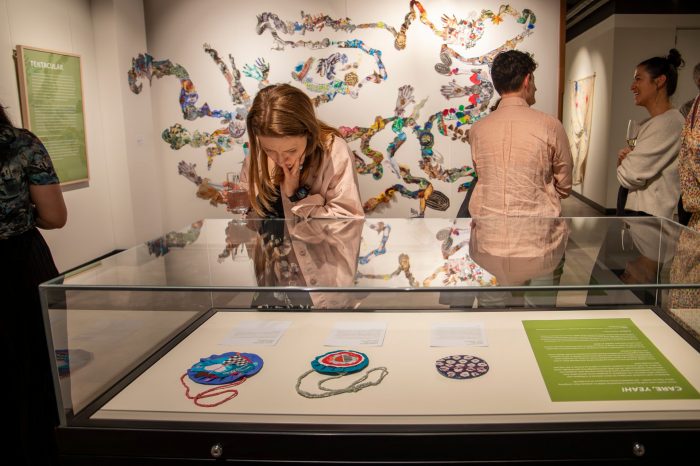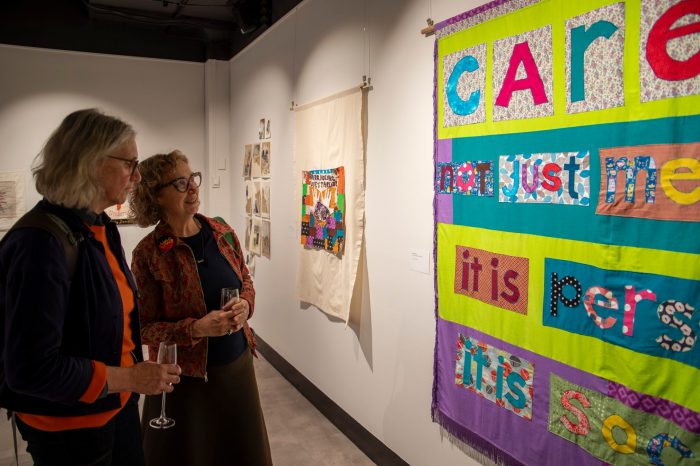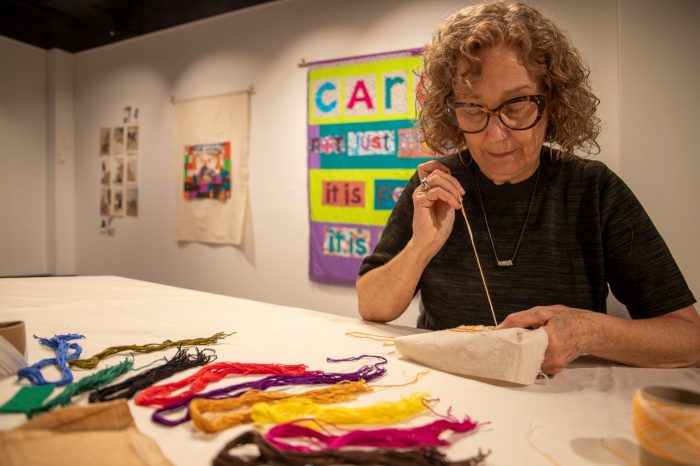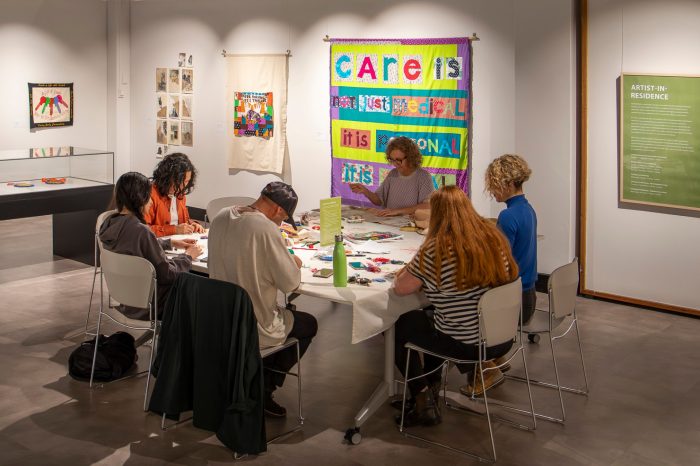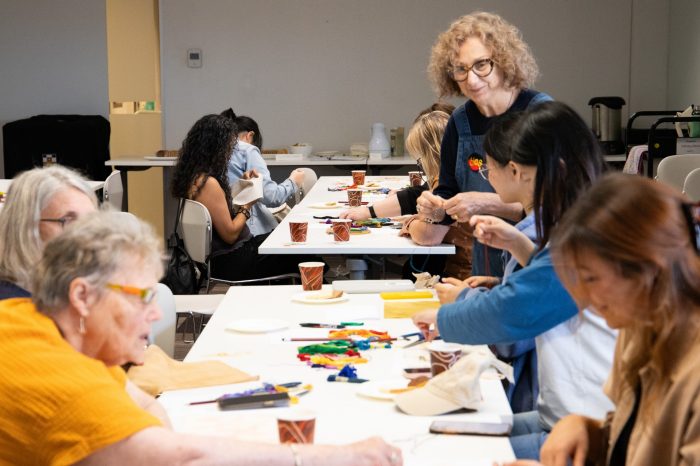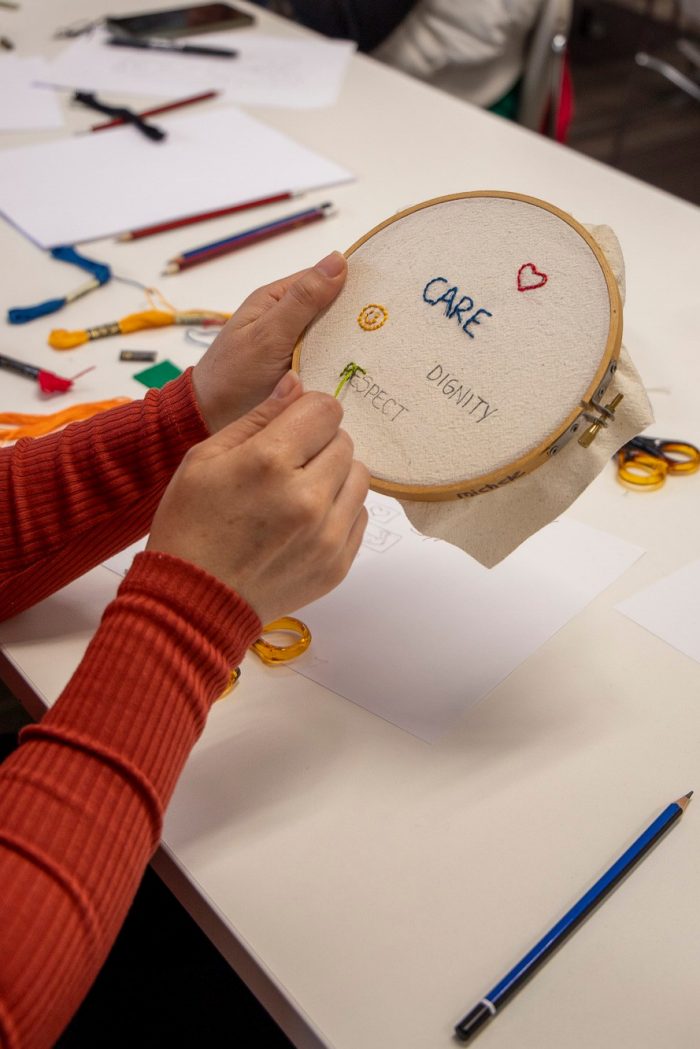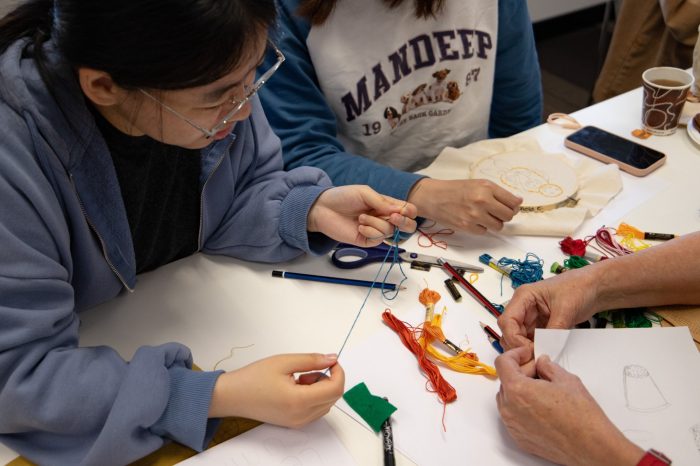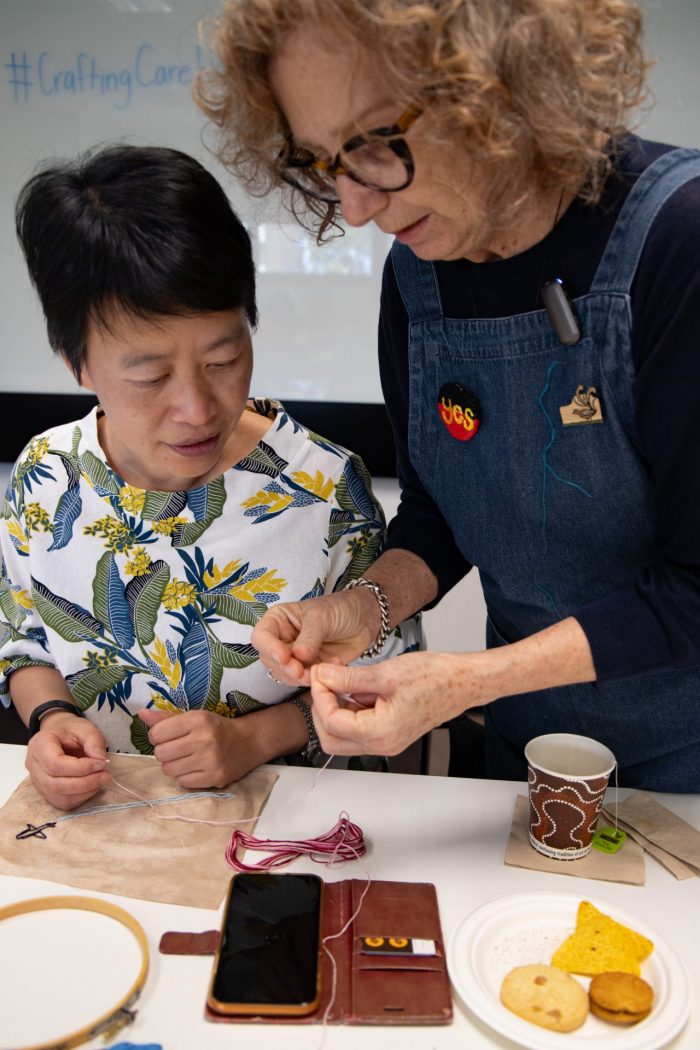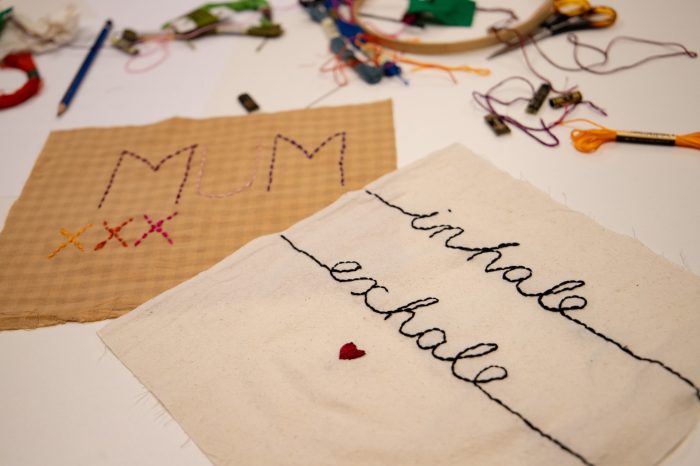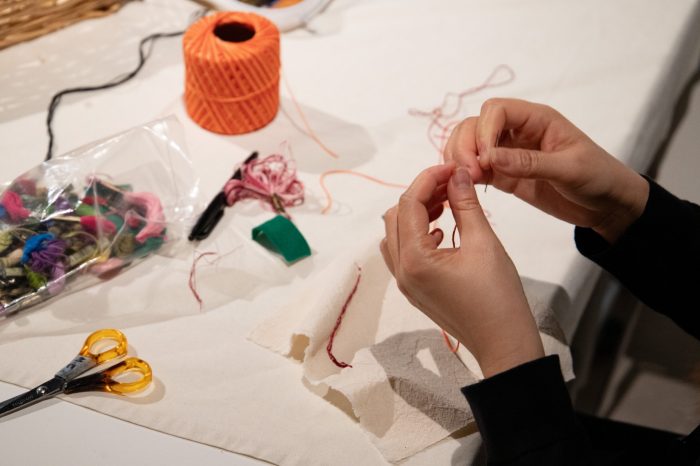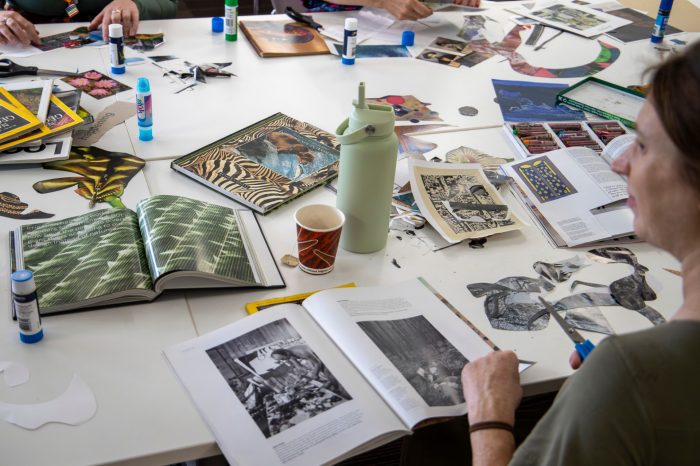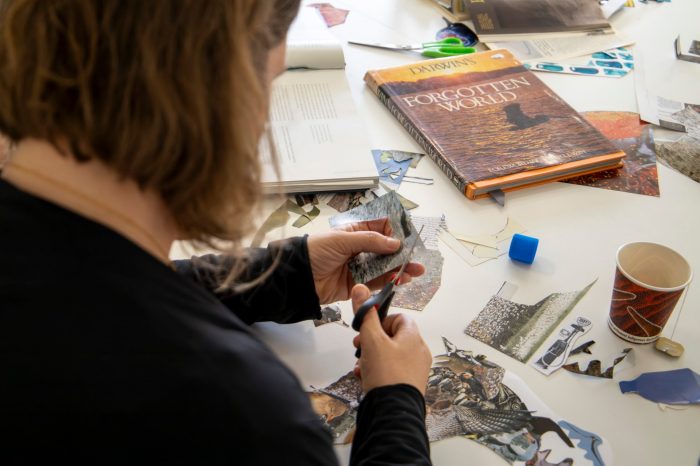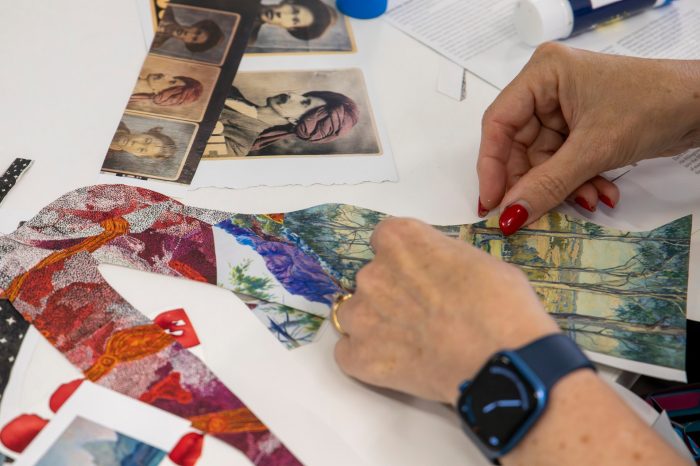Care is a relationship
How might we care more, care better, care together for ourselves, each other, and the places we hold dear?
When:
4 September - 17 November 2023
Where:
Level 5 Main Library
Artist-in-Residence:
Michele Elliot
Partners:
Black Dog Institute
Maridulu Budyari Gumal SPHERE
3C (Career Coaching for Carers)
This exhibition presents art created during four research projects led by the Arts-based Knowledge Translation Lab at Black Dog Institute, the Knowledge Translation Strategic Platform of Maridulu Budyari Gumal SPHERE (Sydney Partnership for Health, Education, Research, and Enterprise), and UNSW’s 3C (Career Coaching for Carers) program.
Each project explores different aspects of care and the social, emotional, and environmental relationships at the heart of health and wellbeing - from caring for a loved one with dementia, caring for our own and others mental health, to caring for the environment in the face of climate collapse. Each project uses art as a tool to reflect and share knowledge and experiences for research and social change.
Content Warning: Artworks in this exhibition explore themes including suicide, sexual assault, abuse and discrimination. Visitors are advised to take care when visiting.
Accessibility: UNSW Main Library is wheelchair accessible and the exhibition includes large-text artwork labels and booklets, audio-described guides, and braille exhibition guides.
Exhibition text
See the exhibition catalogue for essays and the list of works featured. Download the Care is a relationship art labels and project PDFs below.
Art label text (72 KB PDF)
Stitch it for Dementia (2.2 MB PDF)
Mapping Stigma and Resilience (10.2 MB PDF)
Exhibition image gallery
Public programs image gallery
Audio guide
Dr Priya Vaughan and Dr Chloe Watfern audio-describe the exhibition and artworks featured in Care is a relationship. The approximate run time is 19 minutes.
-
Transcript of audio description at exhibition entry
Hello, my name is Priya Vaughan, and I am a postdoctoral fellow at the Black Dog Institute and at the knowledge translation strategic platform of Maridulu Budyari Gumal SPHERE. This audio guide to Care is a relationship features four stops with information about the exhibition themes and descriptions of key artworks. You can access this guide on the UNSW Library exhibition page or by scanning the QR codes using your own device or smartphone in the space. This is stop one, the exhibition introduction.
Welcome to the exhibition Care is a relationship. The exhibition dates are 4 September to 17 November 2023, in the Level 5 exhibition space of UNSW Main Library, located on Bedegal Land. Please note that some artworks extend onto the floor. These areas have been demarcated with tactile tape.
This room contains two adjoining walls painted white. On the left is the exhibition title wall. Large leaf-green letters form an ‘L-shape’ running along the left edge and across the top of the wall, spelling the exhibition title Care is a relationship. The letters are irregularly shaped and have a handmade quality. Nestled below and to the right of the title is the exhibition text in a dark grey font.
The text reads: How might we care more, care better, care together for ourselves, each other, and the places we hold dear? This exhibition presents art created during four research projects led by the Arts-based Knowledge Translation Lab at Black Dog Institute, the Knowledge Translation Strategic Platform of Maridulu Budyari Gumal SPHERE (Sydney Partnership for Health, Education, Research, and Enterprise), and UNSW's 3C (Career Coaching for Carers) program.
Each project explores different aspects of care and the social, emotional, and environmental relationships at the heart of health and wellbeing - from caring for a loved one with dementia, caring for our own and others mental health, to caring for the environment in the face of climate collapse. Each project used art as a tool to reflect and share knowledge and experiences for research and social change.
We acknowledge that this exhibition takes place on unceded Bedegal Country. We pay our respect to Bedegal Elders, who are the custodians of this place and whose knowledge and care of this Country stretches back into deep time and continues through to the present. Always was, always will be, Aboriginal land.
The wall to the right displays a textile work called A Cloak of Care. The textile is a semi-circle measuring 143 x 285 cm suspended from its straight edge via two timber dowels. The calico fabric is a muted pink colour, dyed with avocado pits, and contains a patchwork of tan and brown squares embroidered with brightly coloured thread. The squares feature words related to caregiving and simple illustrations ranging from plants to hands, fruits, and musical instruments. A Cloak of Care is facilitated by Michele Elliot, who is a visual artist, educator and writer living and working on Dharawal Country and is the UNSW Library artist-in-residence for the exhibition. Elliot’s textile, sculpture, installation, and drawing practice involves material explorations relating to human connectivity, mapping, and memory.
Through a series of workshops facilitated by Elliot, participants stitch their stories about giving and receiving care to contribute towards the production of A Cloak of Care. During her residency, Elliot sews and assembles the embroidered squares into the collaborative artwork that evolves throughout the exhibition. Audiences are invited to learn, reflect, and share their experiences during the workshops and while Elliot is on site during the residency.
Elliot writes, “a cloak is a garment that enfolds the wearer. It offers warmth and protection in its action of wrapping around. In this way, our cloak will become a physical and poetic representation of what care means to each person. We will collect these words and images to embellish the cloak and, as we sit and make together, share our experiences around the table.”
-
Transcript of audio description at exhibition gallery 1
This is the second stop in the audio guide for Care is a relationship, featuring a selection of works from the projects Stitch it for Dementia and Care, Yeah!. My name is Chloe Watfern, and I am a postdoctoral researcher at the Black Dog Institute and at the Knowledge Translation Platform of SPHERE. The room contains a series of banners hung along the three walls, two glass display cases at either end and a large worktable in the centre of the room with sewing supplies set out for participants to use.
The Stitch it for Dementia series hangs on the gallery walls suspended from timber dowels and pinned to the walls. These textile banners range in size, the largest being 171 x 165 cm and the smallest 53 x 48.5 cm. They contain words, images, and photographs that express the difficulties and experiences caregivers face when caring for a loved one with dementia. The project is led by Chloe Watfern, facilitated by Michele Elliot, and supported by grants from the UTS Centre for Carer’s Research and the Black Dog Institute. The series began in 2021, and as COVID flared, a small group of carers, researchers and artists gathered online to share stories of caring for a loved one with dementia and to devise textile artworks that would somehow do their stories justice.
The second artwork on the left wall is a banner by Najla Turk with Michele Elliot and Lucie Downer titled Diamond (2021-23), made with cloth and thread, measuring 110 x 125 cm. The banner is suspended from a timber dowel. The background is a large brilliant blue panel that contains a red-edged diamond in shimmering silver fabric. The diamond, positioned in the centre of the banner, has glittering silver trim that traces geometric facets at the top and three long triangles gathering into a point at the bottom. Contained within the diamond facets are words stitched in black thread, including visible, mind, body, heart, soul, voice, choice, control, I can, follow my lead, and I matter.
On the opposite wall, the fourth banner from the left is by Michele Elliot and is titled Care is a Relationship not a Role (2021), which is referenced in the exhibition title. The artwork is made with cloth and thread and is a landscape orientation measuring 119 x 172 cm. It hangs via seven loops of pink paisley patterned fabric from a wooden dowel. The background is a patchwork of heavily patterned pink fabric. The words ‘Care is a relationship not a role’ are arranged into three rows of hand-cut blue letters appliqued onto yellow rectangles. The letters feature an assortment of blue patterned fabrics ranging from polka dots to flowers and chevrons.
The Stitch it for Dementia series is inspired by craftivism – a ‘gentle’ form of protest designed to bring about positive change in the world. The term was coined by sociologist Betsy Greer in 2001 and taken up by the Craftivist Collective. As they say, “If we want our world to be more beautiful, kind and just, then our activism should be beautiful, kind and just.”
Our carer craftivists express the difficulties they faced, or are facing: from stigma and isolation to a lack of support or insight from health professionals, the care sector, and society at large – all issues calling for recognition and change. And yet they also hold onto joy. Their craft embraces the complexity of their experience – navigating relationships and roles, trying to hold all the threads together – sometimes creatively with lots of colours, sometimes tangled, knotted, frustrating and despairing, often exhausting, always a work in progress.
The display cases at either end of the room contain six small fabric rosettes, three in each case. These rosettes were made by women employed by UNSW to celebrate their caregiving labour. They are medals – self-awarded to these champions of everyday life. These rosettes resulted from a creative workshop led by Michele Elliot as part of the UNSW program 3C: Career Coaching for Carers. In 2022, 3C provided career development support for 30 women (cis and trans) across UNSW, as well as research into carer experiences and evidence-based recommendations to make UNSW a more carer-friendly employer.
Workplaces rarely recognise care labour, let alone celebrate it. Colleagues and managers often approach care obligations as problems to be solved rather than important contributions to society. Carers themselves may not even recognise the value of their caregiving work, nor the skills and knowledge they gain through caring for others. To make yourself a medal for caring is a radical act of pride in this vital and often invisible work.
The 3C program and Michele’s creative workshop encouraged women to take pride in their roles as carers. It aimed to create confidence and connection between women carers and to raise their visibility at UNSW.
-
Transcript of audio description at exhibition gallery 2
This is the third stop in the audio guide for Care is a relationship, featuring the sprawling installation Tentacular that stretches across the wall and onto the floor, measuring 356 x 424 cm. The objects installed on the floor are demarcated by grip tape. The artwork is an intricate collage of found imagery extracted from magazines and books carefully constructed by many hands during a series of workshops facilitated by Chloe Watfern and Priya Vaughan. The twisting forms of Tentacular resemble thick tentacles that climb up and around the wall. They contain found images of flora and fauna, like plants, animals, feathers, planets, as well as abstract sketches, and three-dimensional objects like sea glass, dried flowers and leaves. The floor tentacles also contain burnt sticks, coral, brown folded cardstock, and seed pods. The project visually expresses thoughts and feelings about the ongoing climate emergency.
Eco-anxiety, climate distress, solastalgia; an ever-expanding glossary of terms have entered our lexicon to describe the kinds of grief, worry, and despair that people feel in the face of escalating natural disasters, ecological loss, and government inaction on climate change. This project aims to catalyse conversations – from small to large, both private and public – that consider how climate change affects our innermost thoughts and feelings. How can we live and act in a way that allows people and the planet to flourish? How can social, cultural, and psychological forces be of service (and stand witness) to our ecological selves – the interconnected meshwork that constitutes each person and the ecosystems of which they are fundamentally a part?
Tentacular is a physical expression of our creative, lateral, exploratory thinking about how to address these questions. It evolved from previous community projects using the body as a frame to understand climate emotions. The Tentacular body is part human, part cephalopod, part bird, part fungi, and part landscape. During a residency at The Ethics Centre, we invited close collaborators, including artists, psychologists, researchers, and Elders, to contribute to Tentacular. We asked each collaborator to share a story of care for place, self, and/or community in the context of the climate crisis. Many of their stories held something from all three domains – expressions of sorrow, love, hope, rage, advocacy, and connection to place.
-
Transcript of audio description at exhibition gallery 3
Hello, my name is Priya Vaughan, and I am a postdoctoral fellow at the Black Dog Institute and at the knowledge translation strategic platform of Maridulu Budyari Gumal SPHERE. This is the fourth and final stop in the audio guide for Care is a relationship. The four walls of the gallery space contain six life-size figurative outlines suspended from timber dowels. The life-size body maps in Mapping Stigma harness the suggestive possibilities of colour, shape, and found objects to articulate embodied sensation, feeling, and experience. Please note this room explores themes including suicide, sexual assault, abuse, and discrimination. Please take care while visiting.
On the third wall of the gallery space, two body maps hang side-by-side. On the left is Building Blocks (2022) by Dana Alderson. The artwork, made with fabric, paint and marker pen on calico, measures 190.5 x 155.5 cm. On a tan fabric background, a body's shape is suggested through a figurative arrangement of individual black squares measuring approximately five centimetres each. Inside the figure, handwritten words express feelings: down, hopeless, scared, withdrawn, alone, isolated, uncomfortable, rejected. Yellow, orange, and red squares cascade from the figure's arm along the left side of the fabric. On the right, blue, light blue, turquoise, forest green, and yellowish green squares cascade from the figure’s right arm. Layered between the background and the head of the figure is fabric printed with a cloud and seagull design. A sandy beach print with abstract waves lines the bottom of the artwork. Surrounding the figure are words handwritten with a purple marker pen: family, sleep, meditation, cooking, yoga, work, friendship, gardening, food, nature, and beach.
To the right hangs Branded (2022) by Danielle Daws, made with paint, tape and marker pen on calico measuring 192 x 172 cm. Against a background of yellow painted fabric, a blue figure emerges from a black ground. The figure has no legs or hands and is surrounded by a grey shadow. Inside the head of the figure are two nebulous shapes on either side. Long black tentacles with curling tails lined with dots emerge from each shape. Inside the body is a heavily patterned red heart ringed in black. The figure’s left arm bears a hospital bracelet inscribed with the words NAME, UR, DOB, and a black barcode.
These body maps were created by women facing stigma and discrimination resulting from their experiences of mental distress, disability, or refugee background. In this project, we used the term ‘women’ as an inclusive, collective term. So, we welcomed participation from any individual – e.g., cisgender, transgender, non-binary, or feminine-identifying etc. – who identified with the designation of woman.
Body mapping is a creative process that involves tracing your body onto a large piece of paper or fabric and decorating this outline by drawing, painting, sewing, collaging, or writing. These body maps were produced as part of the Women marginalised by mental health, disability, or refugee background research project led by Katherine Boydell and managed by Priya Vaughan. The body maps represent women’s experiences of stigma and discrimination, experiences that often remain invisible and can have profound impacts on quality of life, health, employment, and access to health care. These impacts can be upsetting to talk about and hard to describe. Sometimes orthodox research methods (like filling out a survey) fail to capture such difficult-to-verbalise experiences. Body mapping offers a creative and cathartic way for participants to explore and share their stories. Each map tells a unique narrative to vividly depict its maker’s ideas and life history. Collectively, the maps illustrate both the damaging effects of stigma and discrimination and the healing effects of care and compassion for our mental and physical health.
Past events from this exhibition
Opening event
At the Care is a relationship opening event, the Welcome to Country was performed by Aunty Rhonda Dixon-Grovenor, a Gadigal, Bidgigal, and Yuin Elder and Traditional Descendant from the Sydney (Warrane) and saltwater basin and the South Coast of NSW. Jane Knowles, Associate Director, Research Collections and Exhibitions, was the event MC, and Professor Katherine Boydell, Head of the AKT (arts-based knowledge translation) Lab at the Black Dog Institute and Director of Knowledge Translation, Maridulu Budyari Gumal SPHERE gave the opening address.
Event was held on Tuesday 5 September 2023.
Crafting Care Workshops
Artist-in-residence Michele Elliot led three workshops exploring ideas of care and caregiving through craft. All embroidered squares created during the workshops formed part of a collaborative artwork titled A Cloak of Care.
Crafting Care Workshop
Wednesday 2 August, 11am - 1pm
Crafting Care Workshop – World Alzheimer’s Day
Thursday 21 September, 12.30pm - 2.30pm
Crafting Care Workshop – National Carers Week
Wednesday 18 October, 11am - 1pm
Care in the Climate Crisis: Collage Workshop
As part of the exhibition Care is a Relationship, artist/researchers Chloe Watfern and Priya Vaughan held a workshop that explored care in the climate crisis. Visitors were invited to come along and create a collage that represented their feelings and thoughts about climate change, and about how we might care for ourselves and the planet in the face of climate collapse.
Event was held on Wednesday 15 November 2023, 11am - 1pm.

